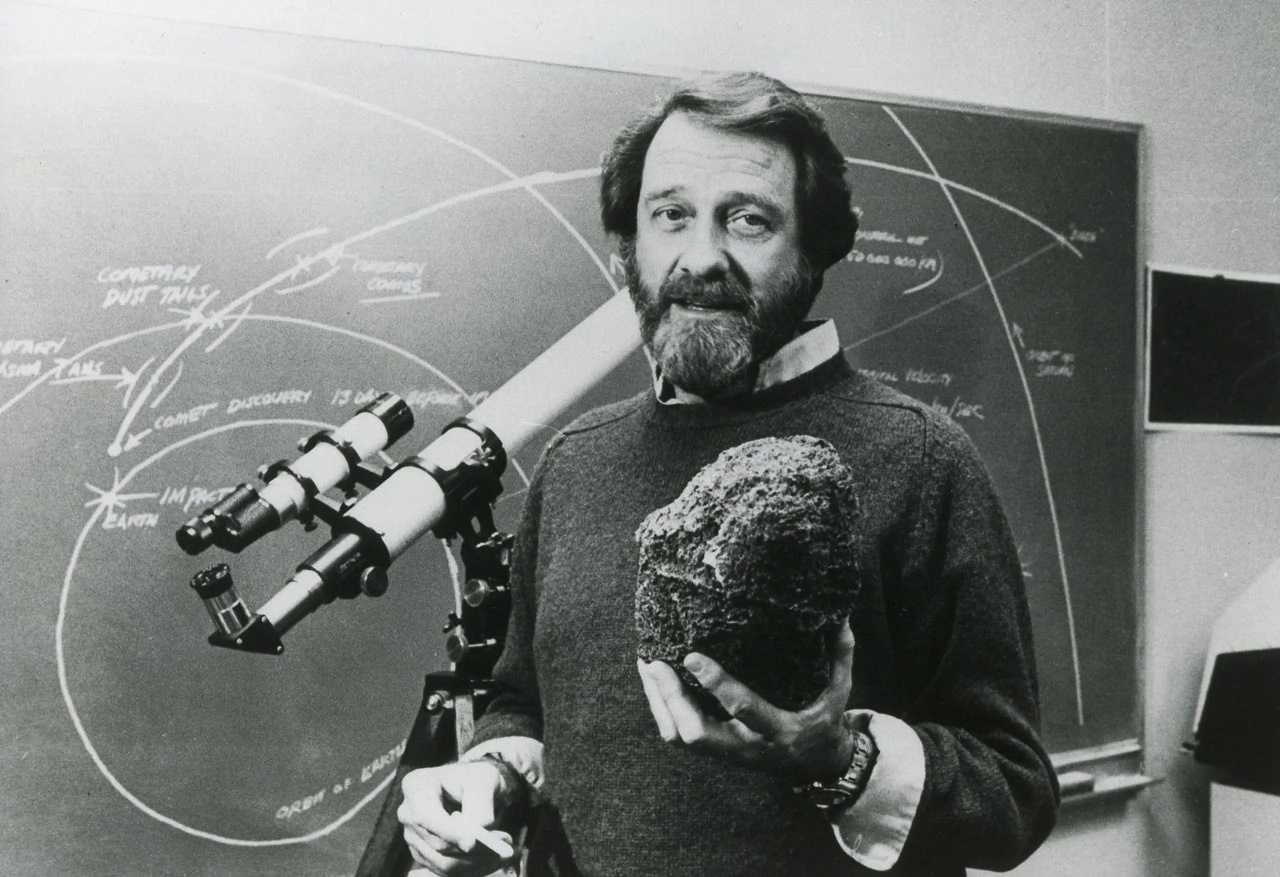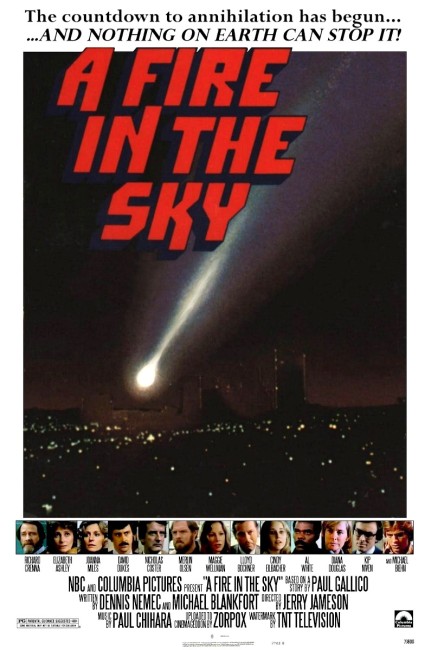USA. 1978.
Crew
Director – Jerry Jameson, Teleplay – Michael Blankfort & Dennis Nemec, Story – Paul Gallico, Producer – Hugh Benson, Photography – Matthew F. Leonetti, Music – Paul Chihara, Special Effects – Joseph A. Unsinn, Production Design – Dale Hennesy. Production Company – Bill Driskill Productions/Columbia Pictures Television.
Cast
Richard Crenna (Dr Jason Voight), Elizabeth Ashley (Sharon Allan), David Dukes (David Allan), Joanna Miles (Jennifer Dreiser), Nicolas Coster (The Governor), Lloyd Bochner (Paul Gilliam), Cynthia Eilbacher (Paula Gilliam), Michael Biehn (Tom Reardon), Merlin Olsen (Stan Webster), Maggie Wellman (Carol), Jenny O’Hara (Ann Webster), Marj Dusay (Ellen Gilliam), John Larch (Colonel Johnson), Andrew Duggan (The President), Diana Douglas (Mrs Reardon), Dino Bachelor (Danny Webster)
Plot
Astronomers detect a comet heading towards Earth. Astrophysicist Jason Voight is rushed to an emergency meeting with The President and makes the prediction that it is going to strike Phoenix, Arizona and with enough force to obliterate the entire city. The news is given to the Arizona governor who convenes various people to discuss the situation where it is decided that because some others state uncertainty about the predictions they will keep quiet about the threat. TV news head Sharon Allan is suspicious after discovering her husband, newspaper editor Paul Allan, was at the meeting and gets Carol, the reporter that Paul is having an affair with, to find what happened from him. Upon getting the truth, Sharon goes to the governor and threatens to go public. He is forced to make a public announcement, although only says that the comet is going to strike in the desert. Sharon risks the governor’s threat to revoke her FCC licence to put Voight on the air and explain the truth of the situation. This forces the governor to mount a citywide evacuation and the opening of often inadequate emergency shelters. Attempts made to divert the comet’s path with a nuclear warhead fail and direct impact seems certain.
The disaster movie was at its height during the 1970s. Beginning with Airport (1970), the genre passed through the likes of The Poseidon Adventure (1972), Earthquake (1974), The Towering Inferno (1974), The Hindenburg (1975), The Cassandra Crossing (1977), Rollercoaster (1977), The Swarm (1978), Hurricane (1979), The Day the World Ended (1980) and several Airport sequels, among others. These always focused around massive spectacles such as a building or vehicle being struck by some type of disaster and featured a cast of characters (usually played by a wide range of familiar Hollywood faces) from different walks of life as they tried to survive and make their way to safety. (For a more detailed overview of the genre see Disaster Movies).
By the end of the 1970s, the disaster movie had become the stuff of a string of tv movies being made in imitation of the big-budget films that were coming out. A Fire in the Sky – not to be confused with the supposedly true-life alien abduction film Fire in the Sky (1993) – was one such tv movie. It was clearly made as a copy of the big-budget Meteor (1979), which similarly featured an asteroid on a collision course with the Earth. Meteor began shooting in 1977. A Fire in the Sky was clearly timed to come out around the time of Meteor‘s originally projected 1978 release date but special effects reshoots meant that it was delayed until towards the end of 1979. Thus A Fire in the Sky ended up airing eleven months earlier than the film it was seeking to emulate.
A Fire in the Sky was directed by Jerry Jameson, who had premiered with the rather silly horror movie The Bat People (1974). Jameson dabbled in the disaster movie for a time – he and had just come from the big hit of Airport ’77 (1977) and would go onto the massive flop of Raise the Titanic (1980), the film that is generally recognised as killing the disaster movie off, followed by the theatrically released tv movie Starflight One (1983). After this, Jameson spent the 1980s onwards working in episodic television. The other interesting name on the credits is that of popular novelist and short storyist Paul Gallico who was almost certainly recruited on the basis of his having written the original 1969 novel that became the basis of The Poseidon Adventure.
A Fire in the Sky ends up being surprisingly well written. Indeed, I would go so far as to say that it emerges as a better and more plausible film than its obvious source Meteor. The script gives the impression that the writers have sat down and done their research on the astronomy and especially the Civil Defence reaction to what a disaster of such magnitude would result in – and the effect shows up in the impressively credible detail on the screen.

Richard Crenna gives an enjoyably hard-headed performance that carries many of these scenes over the fairly nondescript direction. Certainly, some of the characters take you aback seeing the film today – like Richard Crenna as a university professor who casually is sleeping with one of his students. I was particularly amused by the plotting convolution where tv producer Elizabeth Ashley suspects her husband newspaper editor David Dukes of being up to something at the governor’s office and so employs Maggie Wellman, the reporter her husband is having an affair with, to go and seduce the secrets out of him by appealing to her instincts as an investigative journalist. Nicolas Coster’s governor is a variant on Murray Hamilton’s mayor in Jaws (1975), trying to soft-pedal the menace for the sake of business and public order, which rapidly became a genre cliche, but is given such a worthwhile writing that it hardly seems such.
Even the B-plots following a crosscut of supporting characters – penniless rodeo rider Michael Biehn (in one of his earliest roles) and his attempts to ask his girlfriend (Cindy Eilbacher)’s wealthy father (Lloyd Bochner) permission to marry her; Merlin Olsen camping in the desert with a group of kids unaware of what is happening – fail to seem like the pieces of soap opera they usually are in most disaster movies.
The main downside of the film is that Jerry Jameson has a dull and not terribly interesting directorial style, typical of the tv work of the era. The film has an excellent set-up but falters when it comes to the delivery of its disaster scenes. Throughout the comet is economically depicted only by a flashing light on the screen. All of the disaster scenes only occur in the last ten minutes. This consists of some not very convincing model shots of buildings collapsing, hurricane winds and rubble falling within the shelters but very little else. Moreover, the scale of destruction seems considerably less than the massive widescale devastation that Richard Crenna keeps trying to warn that it is. These scenes seem almost to be crying out for a much better and bigger budgeted depiction than they get and weaken what is otherwise a decent little picture.
Full film available here


